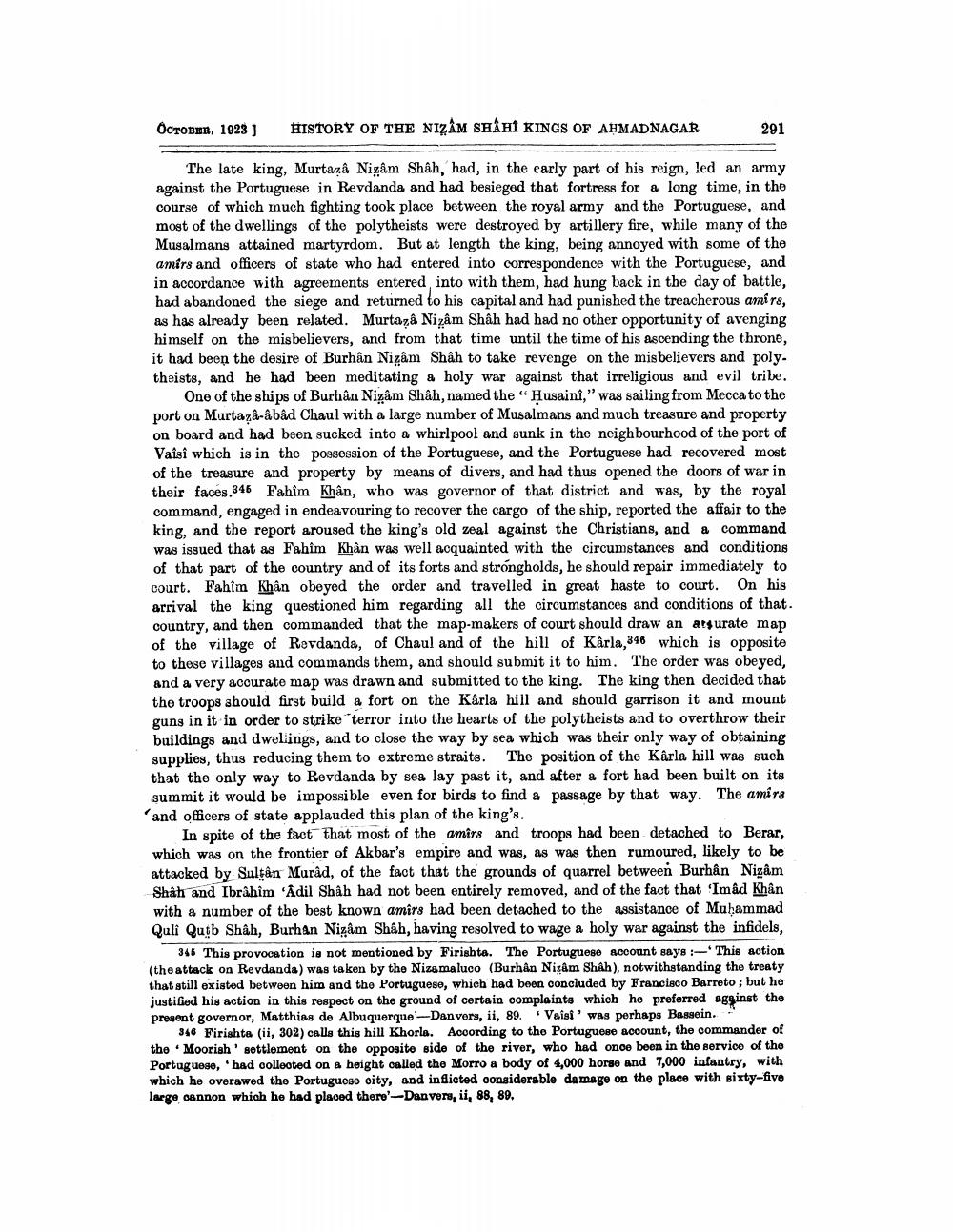________________
OCTOBER, 1923 )
HISTORY OF THE NIZAM SHAHI KINGS OF AHMADNAGAR
291
The late king, Murtaza Nizam Shah, had, in the early part of his reign, led an army against the Portuguese in Revdanda and had besieged that fortress for a long time, in the course of which much fighting took place between the royal army and the Portuguese, and most of the dwellings of the polytheists were destroyed by artillery fire, while many of the Musalmans attained martyrdom. But at length the king, being annoyed with some of the amirs and officers of state who had entered into correspondence with the Portuguese, and in accordance with agreements entered into with them, had hung back in the day of battle, had abandoned the siege and returned to his capital and had punished the treacherous amírs, as has already been related. Murtaza Nizâm Shâh had had no other opportunity of avenging himself on the misbelievers, and from that time until the time of his ascending the throne, it had been the desire of Burhân Nizâm Shâh to take revenge on the misbelievers and polytheists, and he had been meditating a holy war against that irreligious and evil tribe.
One of the ships of Burhân Nizam Shah, named the "Husaini," was sailing from Mecca to the port on Murtaza-âbâd Chaul with a large number of Musalmans and much treasure and property on board and had been sucked into a whirlpool and sunk in the neighbourhood of the port of Vaisî which is in the possession of the Portuguese, and the Portuguese had recovered most of the treasure and property by means of divers, and had thus opened the doors of war in their faces.346 Fahîm Khân, who was governor of that district and was, by the royal command, engaged in endeavouring to recover the cargo of the ship, reported the affair to the king, and the report aroused the king's old zeal against the Christians, and a command was issued that as Fahîm Khân was well acquainted with the circumstances and conditions of that part of the country and of its forts and strongholds, he should repair immediately to court. Fahim Khân obeyed the order and travelled in great haste to court. On his arrival the king questioned him regarding all the circumstances and conditions of that. country, and then commanded that the map-makers of court should draw an arsurate map of the village of Rovdanda, of Chaul and of the hill of Kärla,346 which is opposite to these villages and commands them, and should submit it to him. The order was obeyed, and a very accurate map was drawn and submitted to the king. The king then decided that the troops should first build a fort on the Karla hill and should garrison it and mount guns in it in order to strike terror into the hearts of the polytheists and to overthrow their buildings and dwellings, and to close the way by sea which was their only way of obtaining supplies, thus reducing them to extreme straits. The position of the Karla hill was such that the only way to Revdanda by sea lay past it, and after a fort had been built on its summit it would be impossible even for birds to find a passage by that way. The amire and officers of state applauded this plan of the king's.
In spite of the fact that most of the amirs and troops had been detached to Berar, which was on the frontier of Akbar's empire and was, as was then rumoured, likely to be attacked by Sultan Murad, of the fact that the grounds of quarrel between Burhan Nizâm Shâh and Ibrahim Adil Shah had not been entirely removed, and of the fact that 'Imad Khån with a number of the best known amirs had been detached to the assistance of Muhammad Quli Qutb Shah, Burhan Nizam Shah, having resolved to wage a holy war against the infidels,
345 This provocation is not mentioned by Firishta. The Portuguese account says :- This action (the attack on Revdanda) was taken by the Niza maluco (Burhan Nizam Shah), notwithstanding the treaty that still existed between him and the Portuguese, which had been concluded by Francisco Barreto; but he justified his action in this respect on the ground of certain complaints which he preferred agginst the present governor, Matthias do Albuquerque-Danvers, ii, 89. Vaisi' was perhaps Bassein.
346 Firishta (ii, 302) calls this hill Khorla. According to the Portuguese account, the commander of the Moorish' settlement on the opposito side of the river, who had onoe been in the service of the Portuguese, 'had oollooted on a height called the Morro a body of 4,000 horso and 7,000 infantry, with which he overawed the Portuguese oity, and inflicted considerable damage on the place with sixty-five large cannon which he had placed there'-Danvers, ii, 88, 89.




